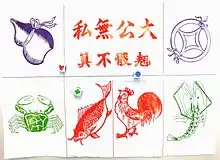| Hoo Hey How | |||||||||||
|---|---|---|---|---|---|---|---|---|---|---|---|
 Hoo Hey How dice | |||||||||||
| Chinese name | |||||||||||
| Traditional Chinese | 魚蝦蟹 | ||||||||||
| Simplified Chinese | 鱼虾蟹 | ||||||||||
| Literal meaning | fish-shrimp-crab | ||||||||||
| |||||||||||
| Alternative Chinese name | |||||||||||
| Traditional Chinese | 魚蝦鱟[1] | ||||||||||
| Simplified Chinese | 鱼虾鲎 | ||||||||||
| Literal meaning | fish-shrimp-horseshoe crab | ||||||||||
| |||||||||||
| Vietnamese name | |||||||||||
| Vietnamese | Bầu cua cá cọp | ||||||||||

Bầu cua cá cọp dice

A playing mat with coloured dice
Hoo Hey How (Yu Xia Xie) (Chinese: 魚蝦蟹; lit. 'Fish-Prawn-Crab', Pinyin: Yu Xia Xie) is a Chinese dice game played with three identical six-sided dice. It is related to Bầu cua cá cọp in Vietnam, Klah Klok/kla klouk in Cambodia,[2] and similar to Crown and Anchor in the West Indies and the American game chuck-a-luck.[3][4][5]
| Face | Hoo Hey How (Yu Xia Xie) | Alternate | Bầu cua cá cọp | Klah Klok |
|---|---|---|---|---|
| 1 | Fish (red) | Fish (green) | Fish (red) | |
| 2 | Calabash (blue) | Stag (brown) | ||
| 3 | Prawn (green) | Cock (red) | Tiger (black) | Prawn (black) |
| 4 | Crab (green) | Prawn (red) | Crab (green) | |
| 5 | Coin (blue) | Prawn (green) | Calabash (blue) | |
| 6 | Cock (red) | Crab (green) | Cock (red) | Cock (yellow) |
 | ||||
References
- ↑ Dobree, C. T. (1955). Gambling Games of Malaya. Kuala Lumpur: The Caxton Press. p. 109.
- ↑ Clere, Brittney. "Traditional Games in Cambodia". Saveur. Retrieved January 4, 2023.
- ↑ The Gamer 1981 p 17 "In Britain, the game is Crown and Anchor and is played with dice spotted (Spades, Hearts, Diamonds, Clubs, Crown and Anchor). In part of the Far East, the game is Hoo Hey How and the dice are spotted (Fish, Prawn, King Crab, Butterfly,"
- ↑ Parlett, David Sidney (1999). The Oxford history of board games. Oxford University Press. p. 31. ISBN 0-19-212998-8.
A substantially similar game is played by the Chinese under the title Hoo-Hey-How, or, more picturesquely, Fish-Prawn-Crab, the six compartments and dice-sides being marked respectively with a fish, a prawn, a king crab, a flower, a butterfly, and a woman.
- ↑ Botermans, Jack (2008). "Sun and Anchor". The Book of Games: strategy, tactics & history. New York, New York: Sterling Publishing Co., Inc. pp. 435–448. ISBN 978-1-4027-4221-7.
This article is issued from Wikipedia. The text is licensed under Creative Commons - Attribution - Sharealike. Additional terms may apply for the media files.